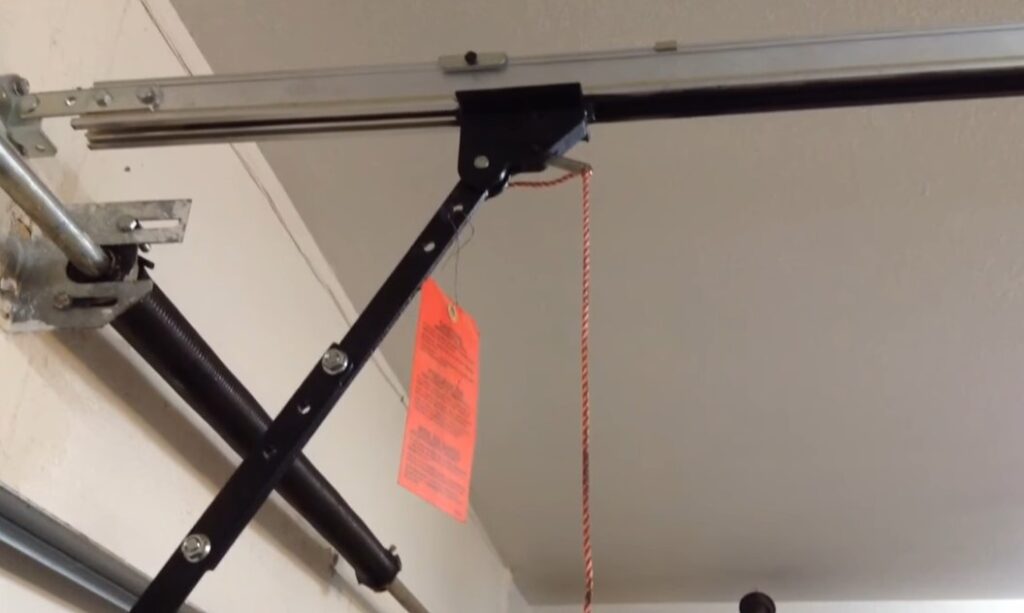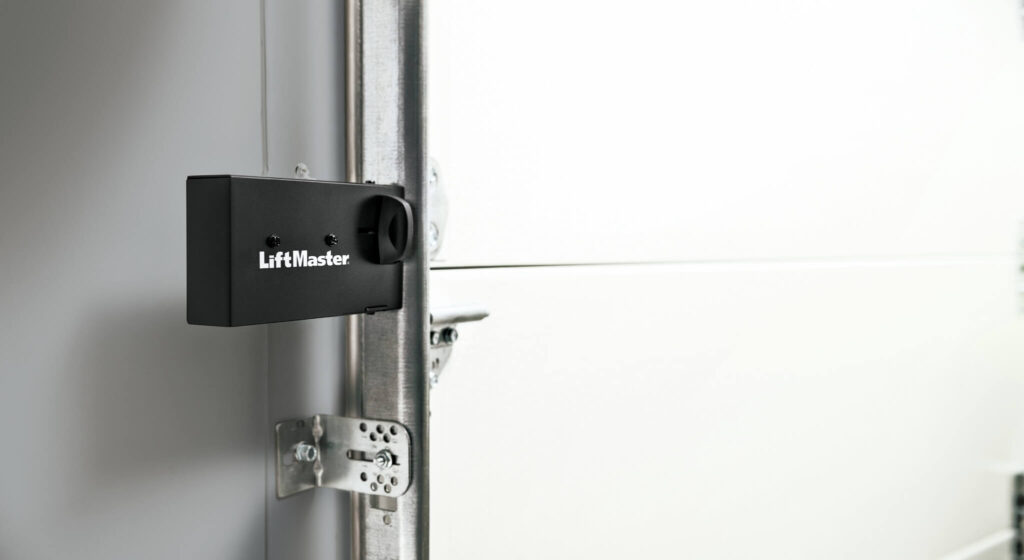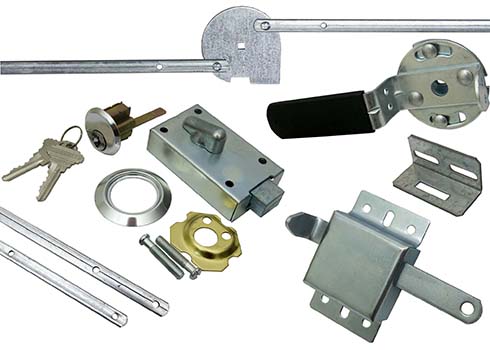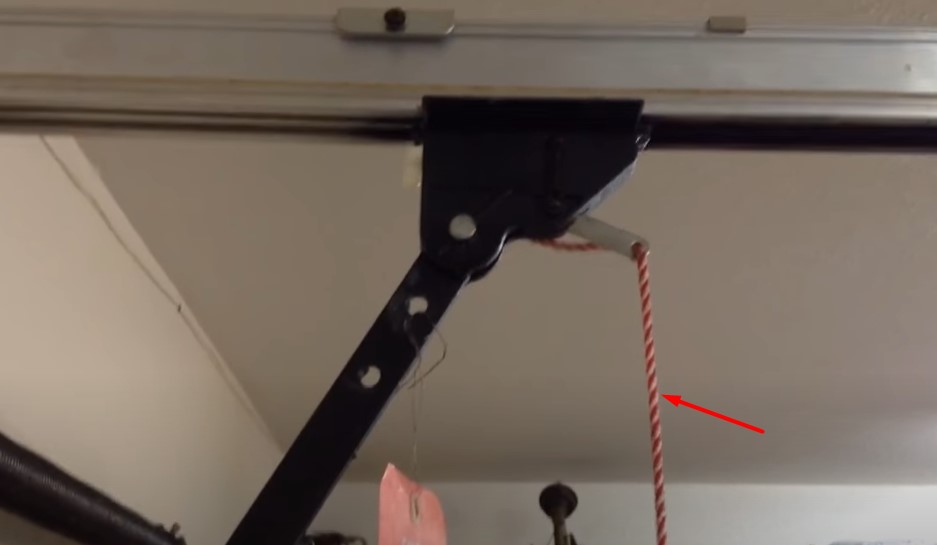Unlocking and securing your garage door’s release lever is a straightforward yet crucial aspect of home security. Whether you’re adjusting settings or ensuring manual access during power outages, mastering the art of locking and releasing the garage door lever is essential.
In this guide, we’ll explore the simple steps to safely manage your garage door release lever, providing you with the confidence and knowledge to keep your garage secure.

What Is A Garage Door Lock Release Lever?
Garage door lock release lever is an essential mechanism that allows you to manually open and close the garage door when the power goes out. This feature is particularly important as it provides an alternative method for accessing your garage.
It is usually located on the garage door opener. This feature disconnects the trolley from the attachment point, allowing you to manually operate the door. It is typically a red cord with a handle that hangs from the opener.
- The garage door lock release lever is a manual override mechanism.
- It allows you to disengage the garage door from the operator.
- It facilitates easy opening and closing of the door when there is no power.

The Importance Of A Garage Door Lock Release Lever
The garage door lock release lever is one of the simplest yet most vital components of the garage door system. It serves as a safety mechanism that allows you to manually open and close the door in case of an emergency.
- The garage door lock release lever is an important safety feature.
- It enables you to operate the garage door even when the power is out.
- It prevents you from being locked out of the garage in case of a power outage.
Why Understanding How To Use Garage Door Lock Release Lever Is Important?
Knowing how to use the garage door lock release lever is essential if you want to be prepared for an emergency. It allows you to access your garage regardless of any power outages that might occur. Moreover, it is essential to know how to use the release lever correctly, as improper use can lead to damage to your garage door.
- Understanding how to use the garage door lock release lever can prevent damage to the door.
- It allows for easy accessibility to the garage during emergencies.
- It eliminates the need for a professional to open the door during power outages.
Now that you know the importance of the garage door lock release lever, ensure that you know how to use it. Familiarize yourself with the mechanism and make sure you know the proper steps to take in case of a power outage, so you can always operate your garage door with ease.
Step-By-Step Guide: Unlocking Your Garage Door With A Lock Release Lever
The Tools You Will Need
Before starting the process of unlocking your garage door, you will need to gather the necessary tools. Here are the items you will need:
- Stepladder
- Pliers
- Lock lubricant
- Flashlight (optional)
- Protective gloves (optional)
Understanding The Parts Of A Garage Door
By understanding the parts of a garage door, you will be able to quickly and easily identify the lock release lever. Here are the essential parts that you need to know:
- Lock handle: This is the handle that you turn to open and close the garage door.
- Trolley arm: This is the arm that connects the garage door to the opener carriage and is located above the door.
- Opener carriage: The carriage is connected to the trolley arm and is pulled by the opener to open and close the door.
- Lock release lever: The lock release lever is an emergency mechanism to disengage the trolley arm from the opener carriage, allowing you to operate the door manually.

Checking The Condition Of The Garage Door
Before attempting to unlock the garage door, you will need to make sure that it is in good condition. Here are the steps to follow:
- Look at the door tracks to ensure they are clear of debris and rust.
- Check the springs and cables to ensure they are not visibly worn or damaged.
- Test the door to ensure it is opening and closing smoothly.
If you notice any issues, it is best to call a garage door professional to fix them before attempting to unlock the door.
Unlocking The Garage Door With The Lock Release Lever
To unlock your garage door with the lock release lever, you will need to follow these steps:
- Locate the lock release lever: The lever is usually located near the top of the door and is connected to a red rope or cord. Pulling this cord will disengage the trolley arm from the opener carriage.
- Place a stepladder under the release lever: Use the ladder to access the lever if it is too high.
- Pull the release cord down: This will unlock the door from the opener carriage.
- Gently lift the door: Without activating the opener, lift the door manually. It should move smoothly.

Using the Emergency Release Cord:
Most garage door openers have an emergency release cord that disengages the trolley from the opener carriage, allowing you to open and close the door manually. This cord usually has a red handle or is prominently labeled.
- Pull the emergency release cord down and away from the door to disengage the trolley.
- Once the trolley is disengaged, locate the spring lever on the carriage. This lever should be extended.
- Push the spring lever back towards the door until it clicks into place, re-engaging the trolley.
- This should lock the release lever and prevent it from being pulled again.
Using a Cable Tie or Wire:
Some garage door openers have holes in the release lever and the carriage assembly that you can use to secure the lever with a cable tie or thin wire.
Simply thread the cable tie or wire through the holes and tighten it to secure the lever in place.

Using a Locking Clip:
Some garage door opener manufacturers offer locking clips specifically designed to secure the release lever.
These clips typically attach to the lever and the carriage assembly with screws or a snap-on mechanism.

Testing The Garage Door After Unlocking
After unlocking the door, you will need to test it to ensure everything is working as it should. Here are the steps to follow:
- Slowly lower the door and make sure it securely clicks into place.
- Test the opener. Press the remote button to operate the door. If the door moves smoothly and the opener is working correctly, the unlocking process was successful.
- Lubricate the lock. If the door is difficult to unlock, apply a small amount of lock lubricant to the lock mechanism.
Remember, if you encounter any difficulties unlocking your garage door, do not force it. Your safety is more important than anything else. Instead, call a professional garage door repair technician to assist you.
How To Lock Release Lever Garage Door Remote?
To lock the release lever on a garage door remote, locate the emergency release mechanism on the garage door opener motor, usually a cord with a red handle. Pull the handle down and away from the motor to disengage the opener from the door.
This prevents remote control operation, ensuring manual opening and closing only. To re-engage, push the handle back towards the motor until it clicks into place.
How To Lock Release Lever Garage Door Opener?
To lock the release lever on a garage door opener, locate the emergency release mechanism, usually marked by a red cord or handle hanging from the opener’s track.
Pull the handle down and away from the door to disengage the opener from the door, allowing manual operation.
To re-lock, push the handle back towards the door until it clicks into place. This ensures the opener remains engaged for remote operation.
How To Reset Garage Door After Pulling Red Cord?
After pulling the red emergency release cord on a garage door opener, to reset and resume automatic operation, lift the garage door manually until it’s fully closed.
Then, press the garage door opener remote or the wall-mounted control button to reconnect the trolley or carriage to the opener carriage.
The door should now operate normally with the automatic opener.
How To Lock Release Lever Garage Door With Key?
Locking the release lever on a garage door with a key typically involves using a key-operated lock cylinder installed on the release mechanism.
First, locate the key-operated lock near the emergency release cord or handle. Insert the key and turn it to the locked position. This prevents unauthorized manual operation of the garage door from outside.
To unlock and enable manual operation, turn the key in the opposite direction. Keep in mind that not all garage door openers come with a key-operated lock, so check your specific model and refer to the manufacturer’s instructions for guidance.
Common Issues: Troubleshooting Garage Door Lock Release Lever
The lock release lever on your garage door is a crucial component that allows you to manually open a closed garage door. However, over time, this mechanism can malfunction, causing a number of different issues.
Here are a few of the most common reasons why homeowners experience problems with their garage door lock release lever:
- The lock release lever is jammed or stuck.
- The lock release cord is broken.
- The lock release mechanism is rusted or corroded.
- The garage door is out of alignment.
What To Do When The Release Lever Is Broken?
If you’re having issues with your garage door lock release lever, don’t panic. There are several steps you can take to troubleshoot the problem before calling in a professional:
- First, carefully inspect the lock release lever itself, looking for signs of damage or wear.
- Check the lock release cord to see if it’s still intact. If it’s broken, you’ll need to replace it.
- Make sure the garage door is properly aligned. If it’s not, this could put extra strain on the lock release mechanism, causing it to malfunction.
- If the problem is rust or corrosion, you may be able to lubricate the mechanism with a penetrating oil to help loosen it up.
How To Fix A Garage Door Lock Release Lever?
If the problem with your garage door lock release lever is due to a mechanical issue, you may need to take steps to repair or replace the entire mechanism. Here’s a quick overview of what you might need to do:
- Disconnect the power to the garage door opener.
- Locate the lock release mechanism and carefully inspect it for damage or wear.
- If the mechanism is rusted or corroded, use a penetrating oil to help loosen it up.
- If necessary, use tools to disassemble the mechanism and replace any damaged or broken parts.
- Reassemble the lock release mechanism and test it to make sure it’s working properly.
If you’re not comfortable troubleshooting or repairing your garage door lock release lever on your own, don’t hesitate to contact a professional.
A trained garage door technician can help diagnose the problem, offer repair or replacement solutions, and help you get your garage door back up and running safely and efficiently.
Garage Door Emergency Release Stuck
If the garage door emergency release is stuck, first ensure the door is fully closed. Try manually lifting and lowering the door while manipulating the release cord or handle.
Apply lubricant to the release mechanism and attempt to move it again. If the issue persists, inspect for any visible obstructions or damage to the release mechanism.
If you’re unable to resolve the problem, it may be necessary to contact a professional garage door technician for assistance in identifying and fixing the issue.
Garage Door Release Cord Broke
If the garage door release cord has broken, you can still disengage the opener by pulling the emergency release lever directly. Locate the lever on the garage door opener track and manually pull it to release the door from the opener carriage.
To avoid future issues, consider replacing the broken release cord with a new one, following the manufacturer’s guidelines and using the appropriate replacement part. If you’re unsure or encounter difficulties, consult a professional garage door technician for assistance.
Security Tips: Ensuring Your Garage Door Is Safe And Secure
The Importance Of Garage Door Security
Garage door security is of the utmost importance as it can provide unauthorized entry to your property. Burglars often break into garages to steal tools, sports equipment, and other valuables. The garage door is often the weakest entry point, so securing it should be a top priority.
How Burglars Break Into Garages
Burglars have various methods to break into garages; here are some of the common ways:
- They can force open the garage door by wedging a crowbar between the door and the floor or by using pliers to pull the emergency release cord.
- If the garage door has windows, burglars can break the glass, reach through, and pull the emergency release cord.
- Hackers can gain access to automated garage doors by hijacking the signal or using a brute-force attack to guess the password.
Enhancing Security With The Lock Release Lever
Here are some tips to ensure that your garage door is secure and cannot be accessed by burglars:
Disable the emergency release lever:
The lock release lever allows the garage door to be opened manually in case of a power outage or malfunction. However, burglars can use it to gain entry by inserting a wire hook through the top of the door and grabbing the release lever. Disabling this lever can help secure the garage door.
Install a lock on the emergency release lever:
You can install a lock on the emergency release lever to prevent burglars from accessing it. This lock can be installed by a professional garage door technician.
Ensure the garage door opener is secure:
A burglar could break into your car to steal the garage door opener remote. You should always keep the opener remote in a secure place, like in your house or in your car’s glove compartment. You can also opt to use a smart garage door opener that can be accessed through your smartphone.
Other Security Measures To Consider
In addition to securing your garage door, you can take the following measures to ensure the security of your garage:
- Install motion sensor lights: Motion sensor lights can deter burglars from approaching your garage.
- Upgrade the garage door opener: You can upgrade to a newer garage door opener model that has advanced security features, like two-factor authentication.
- Install security cameras: Surveillance cameras can act as a deterrent for burglars and provide evidence in case of a break-in.
By taking these security measures, you can ensure that your garage is secure and minimize the risk of burglars gaining unauthorized access.
DIY Vs Hiring A Professional: The Pros And Cons
Benefits Of DIY Garage Door Repairs
Maintaining your garage door is essential not only for the door’s longevity but also for your family’s safety. DIY garage door repairs come with some benefits, such as:
- Cost-saving: You can save money by trying DIY garage door repairs.
- Flexibility: DIY garage door repair gives you the flexibility to work when you have time and at your own pace.
- Enhance your DIY skills: By learning and doing the repairs yourself, you can enhance your DIY skills and knowledge in the process.
When To Hire A Professional
While DIY garage door repairs may sound like a good option, sometimes hiring a professional is a much better choice. You should hire a professional if:
- You have a garage door opener issue, and you don’t have the technical knowledge to fix it.
- Your garage door spring has broken.
- If you are unsure of the safety risks associated with repair work.
The Cost Of Hiring A Professional Vs DIY Repairs
The cost of hiring a professional to fix your garage door can be higher than the cost of DIY garage door repairs. DIY repair may require some simple tools you may already have at home, and you don’t need to pay any contractor fees.
However, if you have to buy new parts or tools or the repair issue is complex, then professional repair may work out cheaper in the long run.
Both options have their pros and cons. DIY repairs work well for simple issues and can save you money, while professional repairs may be necessary for more complex issues. Always remember, if you are unsure, it’s best to hire a professional to avoid any problems or safety risks.
Frequently Asked Questions For How To Lock Release Lever Garage Door
How Do I Lock The Release Lever On My Garage Door?
To lock your garage door release lever, first locate the lever and then slide the lock over.
Why Do I Need To Lock My Garage Door Release Lever?
Locking it prevents burglars from entering your garage through the unlocked release lever.
Can I Lock My Garage Door Release Lever From The Inside?
Yes, you can lock it from the inside by sliding the lock over after closing the garage door.
How Do I Unlock The Garage Door Release Lever?
To unlock your garage door release lever, slide the lock over to the unlocked position and pull the lever down.
Conclusion
Overall, securing your garage door through the use of a lock release lever is an important step in maintaining your home’s safety and security. With the right tools and knowledge, anyone can easily lock and unlock their garage door release lever to ensure maximum protection against potential intruders.
Remember to always exercise caution and pay attention to any potential damages or malfunctions before using your garage door’s lock release lever. Whether you’re a homeowner or a renter, implementing these simple steps can go a long way toward strengthening your garage door’s security and keeping your valuables safe.
So, don’t wait any longer; take action and secure your garage door today!
